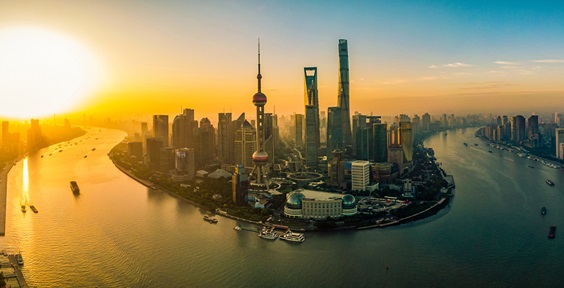Active is: Making complexity investable
A roadmap for the years ahead: Introducing our investable themes

Summary
To help investors navigate today’s drastically different world, we’ve identified three overarching themes: a resurgent China, persistently low yields, and the drive to live and invest more sustainably. We’re using our expertise and insights to explain why these themes represent some of the biggest opportunities and risks for portfolios – and what investors can do.
Key takeaways
|
Guiding our clients through a fundamentally different landscape
The world is experiencing a time of profound change that in some respects has only been accelerated by a global pandemic. The traditional “rules” of investing – which were already being challenged –have become increasingly less relevant. For example, sustainable investing was reaching a tipping point prior to the pandemic, and rather than detracting from this focus, the pandemic has caused investors to double down on their commitment. Now, more people are seeking to invest their money with a particular purpose in mind – whether it’s to address social issues or climate change. Meanwhile, investors are adjusting to the realisation that the current low-interest-rate environment might be a permanent fixture – from which there is no obvious exit.
To address these shifts, we gathered investment professionals and client experts from across Allianz Global Investors for several hours of intense discussion and debate online. Two topics kept recurring. One was the Covid-19 pandemic, which has taken an intense human and economic toll while also upending previous ways of living and working. The other was the accelerating pace of innovation, much of it in high-tech fields such as artificial intelligence.
As we delved deeper into what’s driving economies and markets today – and where they may be headed in the future – we gradually homed in on three overarching and interconnected themes: a resurgent China, persistently low yields, and the drive to live and invest more sustainably. Far more than simple trends, we believe they individually – and together – will have a significant bearing on how and where we invest in the foreseeable future. Because they represent some of the biggest opportunities and risks for client portfolios, we call them “investable themes”.
So what happens next? Over the coming months, we’ll use our expertise and global research capabilities to generate proprietary insights and commentaries that address some of the most pressing opportunities emerging from these themes. And we will apply the capabilities and insights of Allianz Global Investors to create actionable strategies for our clients. First, here’s more detail on our three themes.
An introduction to our three investable themes
What’s next?
These investable themes aren’t static, and we will continue to explore them over a period of years, not just months. You can expect to hear a lot more from us – you will be able to read our proprietary research on these themes, have conversations with our experts, and listen to different perspectives from outside our firm. And we’ll answer your questions, examine your challenges and demonstrate how our solutions can help. That’s how we’ll use our investment themes as a roadmap to achieve the outcomes that you seek.
1) Source: CNBC. Data as at 19 April 2021.
2) Source: Shenzhen Stock Exchange, Shanghai Stock Exchange, Hong Kong Stock Exchange, Bloomberg, Allianz Global Investors. Data as at 31 December 2020.
3) Source: Asian Bonds Online. Data as at 31 December 2020.
4) Source: OECD, AllianzGI Global Economics & Strategy. Data as at 2018.
5) Source: Wind, Allianz Global Investors. China's 2019 GDP as a percentage of world economic output was 16.3%. Data as at January 2021.
6) Source: Opimas. Data as at June 2020.
7) Source: PwC. Data as at 2020.
1617644
Active is: Investing for real-world change
An inflection point for sustainable investing

Summary
Recent growth in ESG fund assets under management shows that people are convinced of the necessity and value of investing sustainably. This commitment will come with significantly higher expectations on the part of investors.
Key takeaways
|







Lower for even longer? How to achieve income and growth in an age of suppressed yields
Monetary policy has always been a key driver of economic growth and financial markets. But the approach of central banks has fundamentally changed in recent years. Stubbornly low interest rates have become the norm, and while long-term rates may rise somewhat in the near future, we are still in the midst of a secular shift to a lower-rate environment. You can see it in the steep fall in 10-year US Treasury yields over the past 40 years.
1981: 16%
10-year US Treasury yield1
2021: 1.6%
10-year US Treasury yield
We believe this won’t end anytime soon. As we move deeper into the recovery from Covid-19, central banks have pledged to keep their monetary policy “easy” for an extended time, with low rates and elevated levels of liquidity in the financial system. Indeed, given the level of government indebtedness and the extent to which markets have become “hooked” on cheap money, few decision makers have the appetite to change. So if the environment becomes lower not just longer, but potentially forever, what are the implications? Are central banks simply the servants of governments as a new “state capitalism” takes hold? Most importantly for investors, how should they reposition their portfolios for the unfolding environment? And how can they push for higher yields and better overall returns while keeping risk in check? We’re using our proprietary research and expert insights to answer these and other pressing questions for clients.
Appreciating China: How to invest in the new economic powerhouse
China is perhaps the only major economy that bounced back quickly from the Covid-19 pandemic. There are many reasons for this, but one of the biggest is that China had already embarked on a long-term economic transformation that paid dividends after the crisis passed. No longer the low-cost manufacturer to the world, China has implemented a long-term growth strategy that will be powered by innovation in technology, data and science. As China’s economy develops, its capital markets are maturing as well. Their integration into the global financial system is likely to be one of the defining structural shifts in the coming decades. While China A-shares are an increasingly common fixture in portfolios, the growth in China’s bond markets also makes the country an option for investors seeking income.
As an investment, China is still an enigma for many, but its markets are nevertheless deep, diverse and dynamic. Now is the time for investors to consider China and its role in portfolios, whatever the asset class and wherever they are investing in the world.
USD 19 trillion
China’s equity market cap – almost double the euro area’s2
USD 15.5 trillion
China’s bond market value – second largest in the world3
35x
China’s increase in R&D spending in last 30 years4
16%
China’s share of global economic output5
Beyond climate: Exploring the frontiers of sustainable investing
Over the years, a growing number of investors have sought to put their capital to work in a sustainable way. This has taken many forms, from considering environmental, social and governance (ESG) factors to focusing on “green” investments. Today, it is fair to say that the consideration of sustainability – in whatever form – is now standard practice for investors and asset managers alike. The growing interest in sustainable investing in recent years has finally translated into significant investments. The priority for the industry is to ensure we meet the high expectations that investors have for those investments. With climate change an urgent topic for many investors, we look beyond conventional thinking on climate to explore the far-reaching implications for biodiversity and other so-called planetary boundaries. And we are prioritising the “S” in ESG as social issues come to the fore.
Overall, we seek to explore the frontiers of sustainability for our clients, because we believe sustainability goes beyond individual products or asset classes. It’s core to the way we do business and engage with the companies in which we invest. We stay connected to the way our clients think about sustainability as well – for example, by helping them focus on outcome-oriented results where the impact is measurable. One way we do this is by using development finance to foster inclusive capitalism, recognising that meaningful progress on sustainability is contingent on economic growth and equality of opportunity.
We also use our position of sustainability leadership to help answer the pressing questions we hear from clients every day. How can I decarbonise my whole portfolio? How can I use my capital to achieve a measurable impact? And how can I support the UN SDGs?
USD 40.5 trillion
in global ESG assets in 20206
+50%
ESG share of total European mutual fund AuM by 20257
2050 & 2060
the year the EU and China, respectively, plan to be carbon neutral